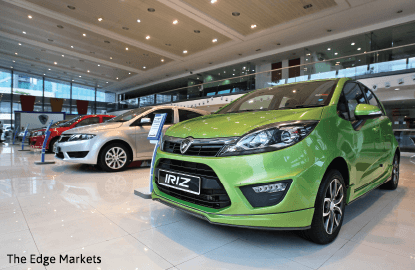
This article first appeared in Corporate, The Edge Malaysia Weekly, on April 18 - 24, 2016.
IT has been four years since Tan Sri Syed Mokhtar Albukhary’s DRB-Hicom Bhd acquired Proton Holdings Bhd for RM1.29 billion or RM5.50 a share. The purchase price valued Proton at only 0.56 times its book value but in hindsight, Khazanah Nasional Bhd probably got the better deal when it sold its 43% stake to DRB-Hicom.
In the three years following the acquisition, Proton would incur RM1.93 billion in after-tax loss for DRB-Hicom (as at March 31, 2015) as revenue fell on weakening sales volume. Likewise, DRB-Hicom’s automotive segment, which includes other marques like Honda, Suzuki, Mitsubishi, Audi and Isuzu, has seen a sharp decline in profitability, posting a pre-tax loss of RM174.3 million in the quarter ended Dec 31, 2015.
In fact, DRB-Hicom would have performed well if not for Proton. In the past four years, the former managed to almost double its Honda sales — from around 46,000 units a year to over 87,000 in 2015. For perspective, Proton’s sales declined about 33% in the same period to 102,175 units as at December 2015.
Separately, DRB-Hicom’s automotive segment saw a big boost from the defence and aviation sub-segment, which contributed RM5.23 billion to revenue in the same period. No breakdown of profitability is given in the group’s financial statement for the automotive segment.
The Proton acquisition has been a huge burden on DRB-Hicom’s balance sheet. The latter had to issue RM815 million in perpetual sukuk musharakah to help fund the car maker. The perpetual sukuk programme is for up to RM2 billion.
This is on top of the RM1.8 billion in Islamic medium term notes (IMTN) that DRB-Hicom issued to acquire Proton in the first place. The repayments for the IMTN began this month and will go on until March 2022.
Combined, DRB-Hicom’s gross gearing has shot up to 0.91 times from only 0.26 times before the acquisition of Proton.
Yet, DRB-Hicom is looking to borrow more money, albeit from the government this time. Recall that two weeks ago, the government conditionally approved a soft loan of RM1.5 billion for Proton. This is interesting since DRB-Hicom can still raise up to RM1.185 billion from its perpetual sukuk programme, which was approved by the Securities Commission Malaysia in late 2014.

In practice, however, raising more debt in the capital market might be challenging for DRB-Hicom. At the very least, it will be more expensive.
The group’s rating outlook was recently downgraded from “stable” to “negative” by Malaysian Rating Corp Bhd. It has an AA-IS for its IMTN and AIS for the perpetual sukuk.
“The outlook revision was mainly driven by the impact of the challenges in the domestic automotive industry on the group’s key automotive subsidiary, Proton Holdings Bhd, as it contends with increased competition and weakening consumer sentiment,” wrote MARC in February.
“The support extended to Proton by way of advances from the holding company to meet ongoing capital expenditure would continue to exert pressure on the group’s credit profile,” it added.
Based on Proton’s accounts for the year ended March 31, 2015, it had RM403.42 million of payables due to DRB-Hicom. Of this amount, RM400 million was structured as a 7.5% interest-bearing unsecured loan from the shareholder, repayable upon demand. The FY2015 accounts mark the first time Proton reported a loan from DRB-Hicom.
Simply put, DRB-Hicom’s shareholders might be better off without the Proton acquisition, which has been value destructive. Since the acquisition, DRB-Hicom’s shares had lost some 55% of their value as at their RM1.07 close last Wednesday.
Still, it is not all doom and gloom for DRB-Hicom as far as Proton is concerned. At least, Lotus Group International Ltd is almost back in the black. The company’s after-tax loss narrowed to RM191 million in FY2015 ended March 31. It had incurred losses of RM361 million and RM807 million in FY2014 and FY2013 respectively.
Lotus’ sales improved to 2,105 units in FY2015 from 1,301 in FY2014.
The real value in Proton, however, lies in the land on which its Shah Alam plant is sited. This is how DRB-Hicom was able to retain its AA rating and attract positive analyst recommendations. RHB Research and AmInvestment have a “buy” call on the company with target prices of RM1.30 and RM1.50 respectively.

“We believe Proton is already trading close to trough valuations and presents a strong case from a risk-reward perspective. DRB-Hicom owns other profitable businesses and valuable assets but trades at a fraction of its book value. Applying a price-to-book value (P/BV) of 0.35 times (from 0.3 times), that is at a 50% discount to its five-year median P/BV derived target price of RM1.30 (from RM1.14). The higher target price is to reflect the increased impetus to prioritise a sustainable turnaround at Proton that could be a major rerating catalyst for DRB-Hicom,” says RHB Research.
AmInvestment’s target price is based on 0.4 times DRB-Hicom’s P/BV and is strictly based on the company’s break-up value and takes into account further losses at Proton.
But in four years, DRB-Hicom has not been able to migrate Proton’s manufacturing activities to the new plant in Tanjung Malim, although both factories are only 35% utilised. The 247-acre Shah Alam land was previously slated for a development with a gross development value of RM4 billion, which would have given Proton plenty of gunpowder for R&D while keeping its operations lean.
Perhaps, with Proton backed into a corner, DRB-Hicom will finally be able to unlock some value from the national automaker for shareholders.
Save by subscribing to us for your print and/or digital copy.
P/S: The Edge is also available on Apple's AppStore and Androids' Google Play.